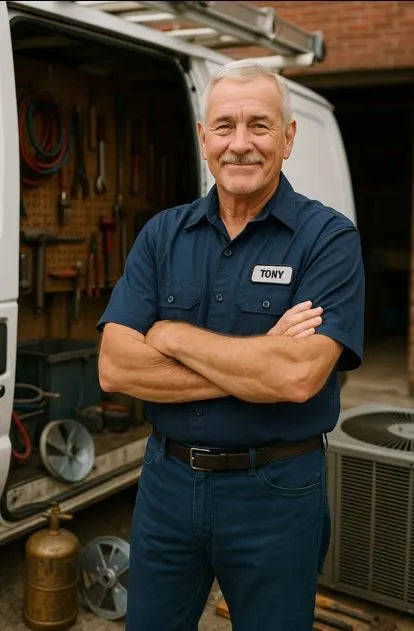Is a 3-Ton Daikin Light Commercial System Enough for Your Business? Tony’s Sizing Rules for Retail, Restaurants & Offices
When business owners ask Tony whether a 3-ton Daikin Light Commercial split system (DX3SEA3630 + AMST36CU1400) is enough for their space, they expect a quick answer.
Tony doesn’t give quick answers.
“Because the building decides the tonnage — not you, not me, not the equipment brochure.”
A 3-ton system can be perfect, undersized, or oversized depending on real commercial heat gain, airflow, occupancy, appliances, duct layout, and ceiling height. This guide breaks down the rules Tony uses in the field when sizing cooling for small businesses, offices, retail spaces, salons, and other light-commercial environments.
1. First Rule: Square Footage Doesn’t Determine Commercial Tonnage
Residential sizing formulas do NOT work in commercial spaces.
Two 1,200 sq ft buildings can require completely different cooling loads depending on:
-
equipment heat
-
number of people
-
sun-facing glass
-
lighting levels
-
ceiling height
-
ventilation requirements
-
duct layout
-
building envelope
Tony says it straight:
“A 1,200 sq ft bakery can need triple the cooling a 1,200 sq ft insurance office does.”
[Commercial HVAC Load Calculation Standards for Light Business Applications]
2. Spaces Where a 3-Ton Daikin Is the Right Call
A 3-ton Daikin system works extremely well when the building has controlled heat gain and predictable occupancy.
✔ Small Offices (1–8 employees)
Computers, printers, standard lighting — steady and predictable cooling.
✔ Small Retail Shops
Boutiques, gift shops, phone stores, small electronics.
Foot traffic is moderate and equipment heat is low.
✔ Salon Suites (NOT full salons)
1–2 stations, small footprint.
✔ Medical/Dental Offices (few rooms)
Exam rooms + reception + admin space.
✔ Church Offices / Nonprofit Offices
Light heat load and low staff count.
✔ Small Storage or Utility Rooms
Especially when ceilings are normal height.
[Commercial Building Heat Gain Assessment]
3. Spaces Where a 3-Ton System Will NOT Work — Tony Won’t Even Quote It
Tony refuses to install a 3-ton system in these businesses:
❌ Full Restaurants
Kitchens with ovens, fryers, dishwashers, exhaust hoods — impossible for 3 tons.
❌ Full-Service Hair Salons
10 blow dryers = massive heat production.
❌ Fitness Studios / Gyms
Body heat + activity load = far beyond 3-ton capability.
❌ High-Ceiling Buildings
16–20 ft ceilings effectively double cooling volume.
❌ Retail with Large Sun-Facing Windows
Solar load crushes a small system.
❌ Multi-Room Offices With Long Duct Runs
Branches reduce airflow to critical rooms.
Tony’s rule:
“If the room heats up faster than the AC removes heat, you’re undersized — period.”
[ Solar Heat Gain Engineering Manual]
4. What 13.8 SEER2 Really Means for a Commercial Business
The Daikin system is 13.8 SEER2, which meets the new national standard.
Tony breaks it down simply:
“SEER2 is real-world efficiency. A 13.8 SEER2 system cools better in tough conditions than old 14–15 SEER units ever did.”
Commercial benefits:
-
handles long operating hours
-
stays efficient under constant load
-
ideal for open floor businesses
-
lowers monthly power usage compared to older systems
5. Ceiling Height: The Hidden Tonnage Multiplier Most Owners Miss
Commercial buildings often have ceilings between 12–20 ft, not the 8–9 ft used in residential load calculations.
Tony’s guidelines:
✔ 8–10 ft ceilings → 3 tons may be enough
✔ 10–14 ft ceilings → 3–4 tons
✔ 14–20 ft ceilings → 5–7 tons
Cooling air must fill an entire volume, not just a floor area.
[Commercial HVAC Ceiling Height ]
6. Internal Heat Loads: The True Difference Between Undersized & Correctly Sized
Every business produces a unique internal heat load.
Examples:
-
ovens or steam tables
-
refrigerators
-
blow dryers
-
bright track lighting
-
computer clusters
-
crowded waiting areas
-
POS and display equipment
A 900 sq ft bakery can demand more cooling than a 1,500 sq ft office.
The Daikin 3-ton system performs best when internal heat-producing equipment is minimal.
7. Ductwork & Airflow: The Real Deciding Factor (Not the Tonnage)
The AMST36CU1400 air handler requires:
✔ 1,200–1,350 CFM
✔ Total static pressure under 0.50 in. w.c.
If ducts are:
-
undersized
-
leaky
-
kinked
-
stretched
-
misaligned
-
unbalanced
…a 3-ton system will NOT cool your business properly, even if the tonnage is right.
Most commercial AC complaints Tony gets come from bad ductwork, not bad equipment.
8. When 3 Tons Works With the Right Setup (Zoning, Multi-Units, Mixers)
Sometimes a 3-ton Daikin works perfectly IF paired with:
-
zoning dampers
-
a second smaller unit for a kitchen/back office
-
ceiling fans to eliminate stratification
-
duct balancing
Many businesses have uneven cooling loads throughout the day.
Zoning + proper duct design solves those issues.
9. Tony’s “Is 3 Tons Enough?” On-Site Checklist
Tony greenlights a 3-ton Daikin only when:
✔ Conditioned space is 800–1,600 sq ft
✔ Ceiling height is ≤ 10 ft
✔ Internal heat load is moderate
✔ Ductwork supports required CFM
✔ Windows are manageable
✔ Ventilation requirements are normal
✔ Occupancy is predictable
✔ Equipment load is low (no kitchen appliances)
One violation of these rules = Tony upsizes the system.
10. Tony’s Final Verdict: A 3-Ton Daikin Light Commercial Unit Is a Workhorse — When the Building Earns It
Tony’s summary:
✔ Ideal for
-
offices
-
small shops
-
salon suites
-
medical rooms
-
nonprofits
-
backrooms
-
small studios
✔ Not suited for
-
restaurants
-
gyms
-
full salons
-
high-ceiling facilities
-
heavy equipment businesses
-
high-sunload retail
A properly matched 3-ton Daikin cools efficiently, quietly, and reliably.
A mismatched one will struggle, short cycle, and run hot all day.
Match the equipment to the building.
That’s Tony’s way.
In the next blog, Tony will discuss the efficiency and performance of this system.







